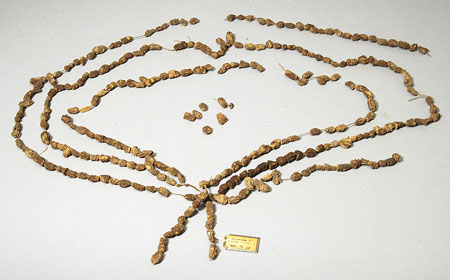Accession Number:
1884.75.28
Country:
?Sudan
Region:
[Southern Sudan?]
Date Made:
Before 1884
Materials:
Wood Plant , Plant Stem , String , Bead
Process:
Perforated , Strung , Twisted , Tied , Knotted
Dimensions:
Fragmentary, so not possible to measure original hanging length. Individual beads vary, one example L = 14.6, W = 11.3, th = 8.5; cord diam = 0.5 mm [RTS 8/8/2005].
Max L [bundled] = 420 mm [NB 8/8/2005].
Weight:
Individual beads 0.4 - 0.6 g
Other Owners:
Possibly purchased from the Anthropological Institute in a sale. Its previous source is not known (but could possibly have been Petherick via J.G. Wood, see notes) [RTS 8/6/2004].
This object was listed in the Delivery Catalogue as having been transferre
PRM Source:
Augustus Henry Lane Fox Pitt Rivers founding collection
Acquired:
Donated 1884
Collected Date:
Prior to 1884
Description:
Neck ornament made from a series of irregularly cylindrical to barrel-shaped beads, cut from lengths of the woody stem of the
cyperus
plant and perforated along their lengths, with the occasional pendant example pierced through one end.
The surface of the wood is a mid brown colour (Pantone 7531C), with a lighter yellowish colour visible where the surface has been scratched or lost (Pantone 7507C).
The wood is naturally scented with a strong smell somewhat like sandalwood.
These have been strung onto a fine cord made from 2 strands of plant fibre, twisted together.
The cord is very brittle, and has already broken in a number of places, making it impossible to determine the exact stringing arrangement of the group.
At present, there are 6 broken strands of beads of varying length, 6 loose beads, then one group where 8 different broken strands of beads have been knotted together at the centre; if this represents the back of the necklet, then it may have originally consisted of a single, long strand of beads that was doubled over twice to produce 4 hanging loops or strands.
The necklet has a total of 262 beads.
The beads are of variable size, but a typical example is 14.6 mm long, 11.3 mm wide and 8.5 mm thick, with individual beads weighing between 0.4 and 0.6 grams each.
The cord has a diameter of 0.5 mm.
This object may have been purchased from the Anthropological Institute in a sale. The original collector is not known, but could have been John Petherick, via J.G. Wood. It was probably sent by Pitt Rivers to the Bethnal Green and South Kensington Museums for display between 1874 and 1884, and was transferred from the latter in 1884 to become part of the founding collection of the Pitt Rivers Museum.
For other cyperus sp. necklaces, see 1884.75.26-7, collected by Petherick, and 1942.1.447, from an unknown donor.
Petherick does not comment on the use of scented wood for personal ornaments of this kind, so it is not clear which culture this should be attributed to. Presumably these beads are made from the woody stem or culm of the plant.
Rachael Sparks 30/9/2005.
This object may have been purchased from the Anthropological Institute in a sale. The original collector is not known, but could have been John Petherick, via J.G. Wood. It was probably sent by Pitt Rivers to the Bethnal Green and South Kensington Museums for display between 1874 and 1884, and was transferred from the latter in 1884 to become part of the founding collection of the Pitt Rivers Museum.
For other cyperus sp. necklaces, see 1884.75.26-7, collected by Petherick, and 1942.1.447, from an unknown donor.
Petherick does not comment on the use of scented wood for personal ornaments of this kind, so it is not clear which culture this should be attributed to. Presumably these beads are made from the woody stem or culm of the plant.
Rachael Sparks 30/9/2005.
Primary Documentation:
Accession Book IV entry
[p.
166]
-
[insert] 1884.75 cont.
[end insert]
PERSONAL ORNAMENTS NUTS, SEEDS etc (cont.
) [insert] 28 [end insert] - Long necklet of ditto [tubers of
cyperus
] C.
AFRICA.
?Anthrop[ological] Inst[itute] (6).
Collectors Miscellaneous XI Accession Book entry [p. 5] - ANTHROPOLOGICAL INSTITUTE [p. 6] - 1884.75.28 6 12 Long necklet of cyperus tubers. C. AFRICA (P.R.).
Delivery Catalogue II entry [p. 360] - Miscellaneous [...] Necklace, ?pieces of root of tree, 6. 388 to 398. Not exhibited.
Pre-PRM label - 6 [N.B. 'DCF 2004-2006 What's Upstairs?' 4/8/2005; semi-circular brown tag stuck over string, number not clear; RTS 8/8/2005]
Pitt Rivers Museum label - Long necklet of tubers of Cyperus . C. AFRICA P.R. Coll. [rev] round label "6" written in ink. [rectangular metal-edged label, tied to object; N.B. 'DCF 2004-2006 What's Upstairs?' 4/8/2005]
Collectors Miscellaneous XI Accession Book entry [p. 5] - ANTHROPOLOGICAL INSTITUTE [p. 6] - 1884.75.28 6 12 Long necklet of cyperus tubers. C. AFRICA (P.R.).
Delivery Catalogue II entry [p. 360] - Miscellaneous [...] Necklace, ?pieces of root of tree, 6. 388 to 398. Not exhibited.
Pre-PRM label - 6 [N.B. 'DCF 2004-2006 What's Upstairs?' 4/8/2005; semi-circular brown tag stuck over string, number not clear; RTS 8/8/2005]
Pitt Rivers Museum label - Long necklet of tubers of Cyperus . C. AFRICA P.R. Coll. [rev] round label "6" written in ink. [rectangular metal-edged label, tied to object; N.B. 'DCF 2004-2006 What's Upstairs?' 4/8/2005]
Display History:
This object is listed in Delivery Catalogue II but it is noted therein that it was not exhibited at Bethnal Green Museum or South Kensington Museum (although it may actually be implying that the object was not exhibited at the PRM) [AP].






